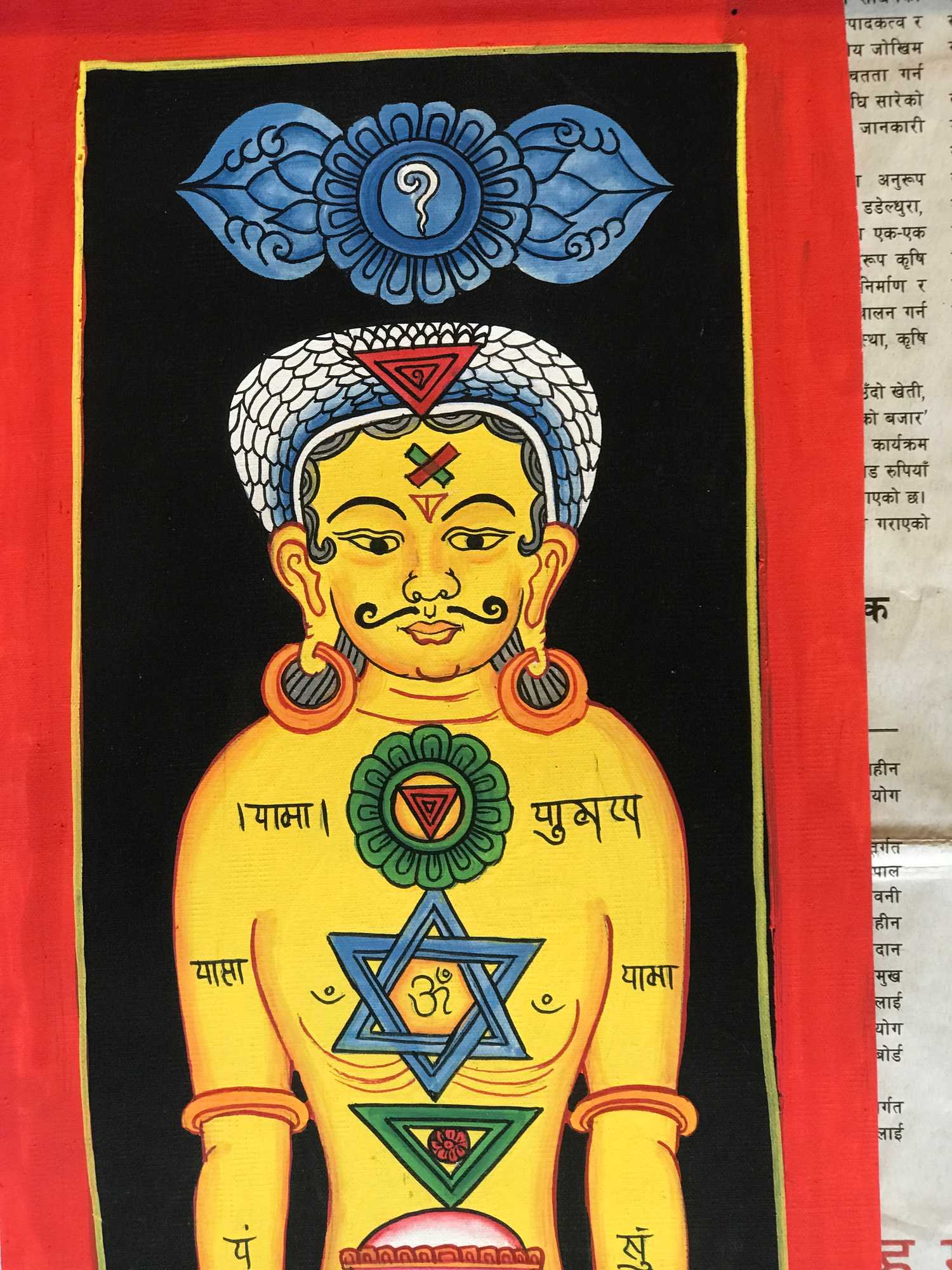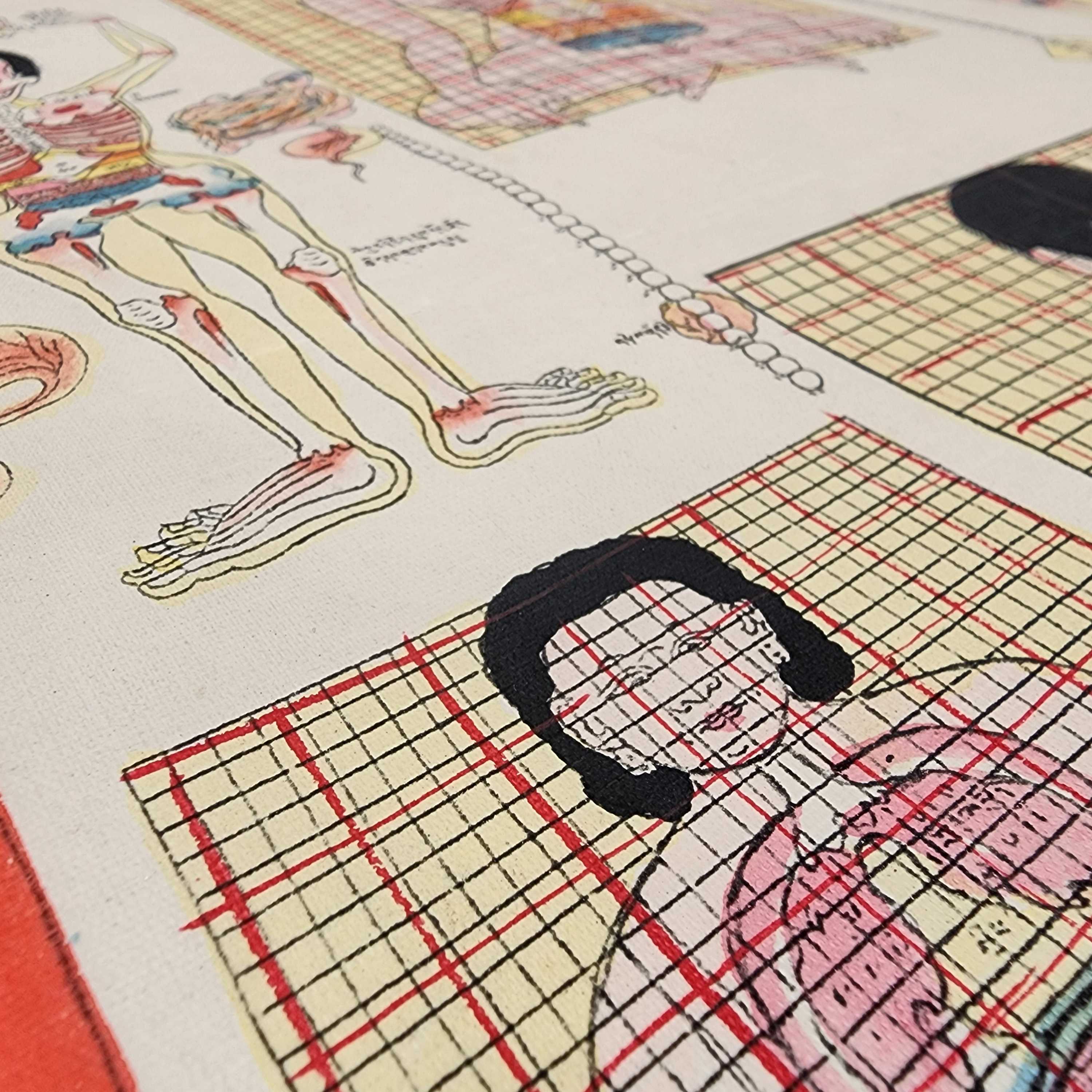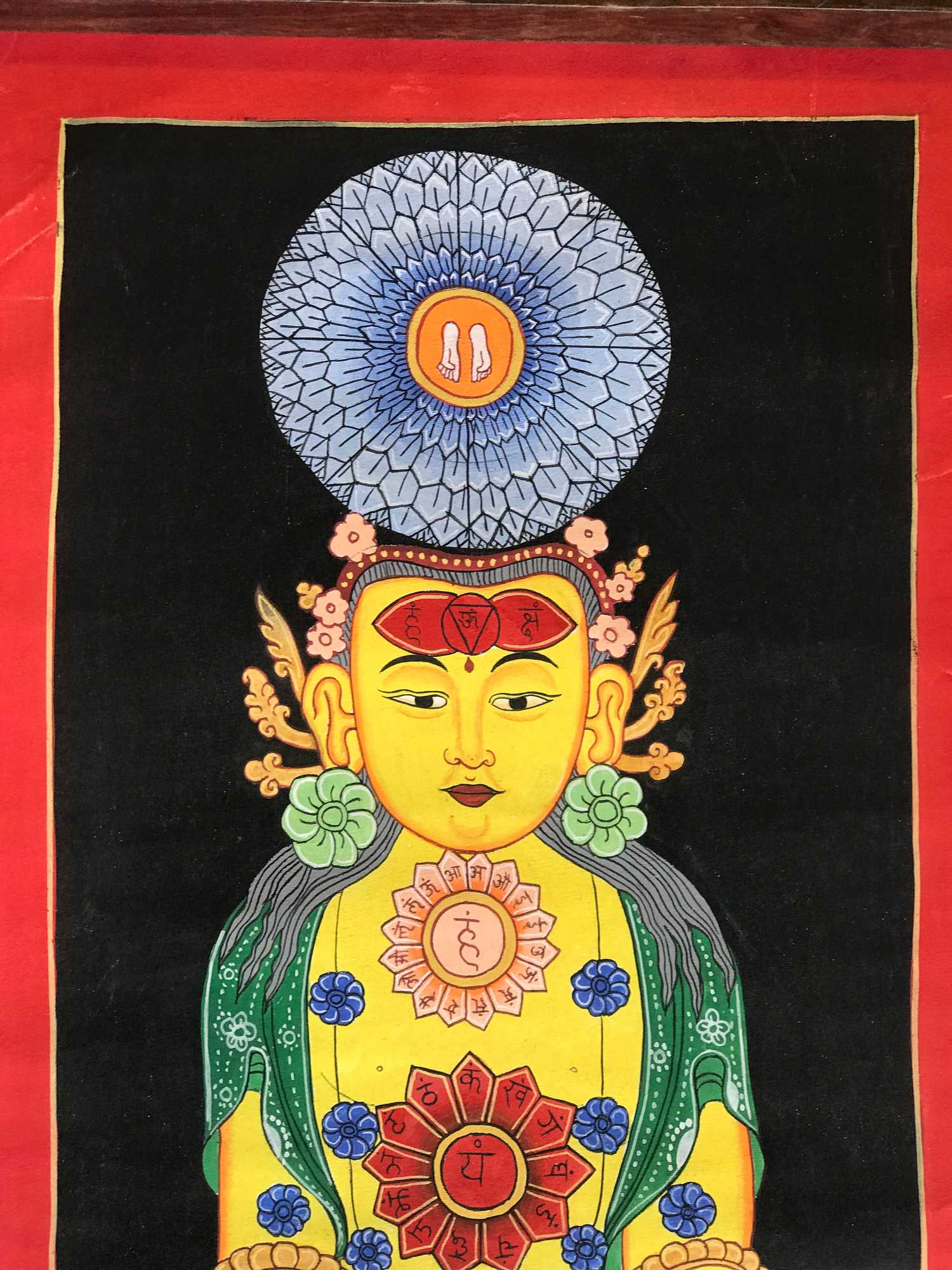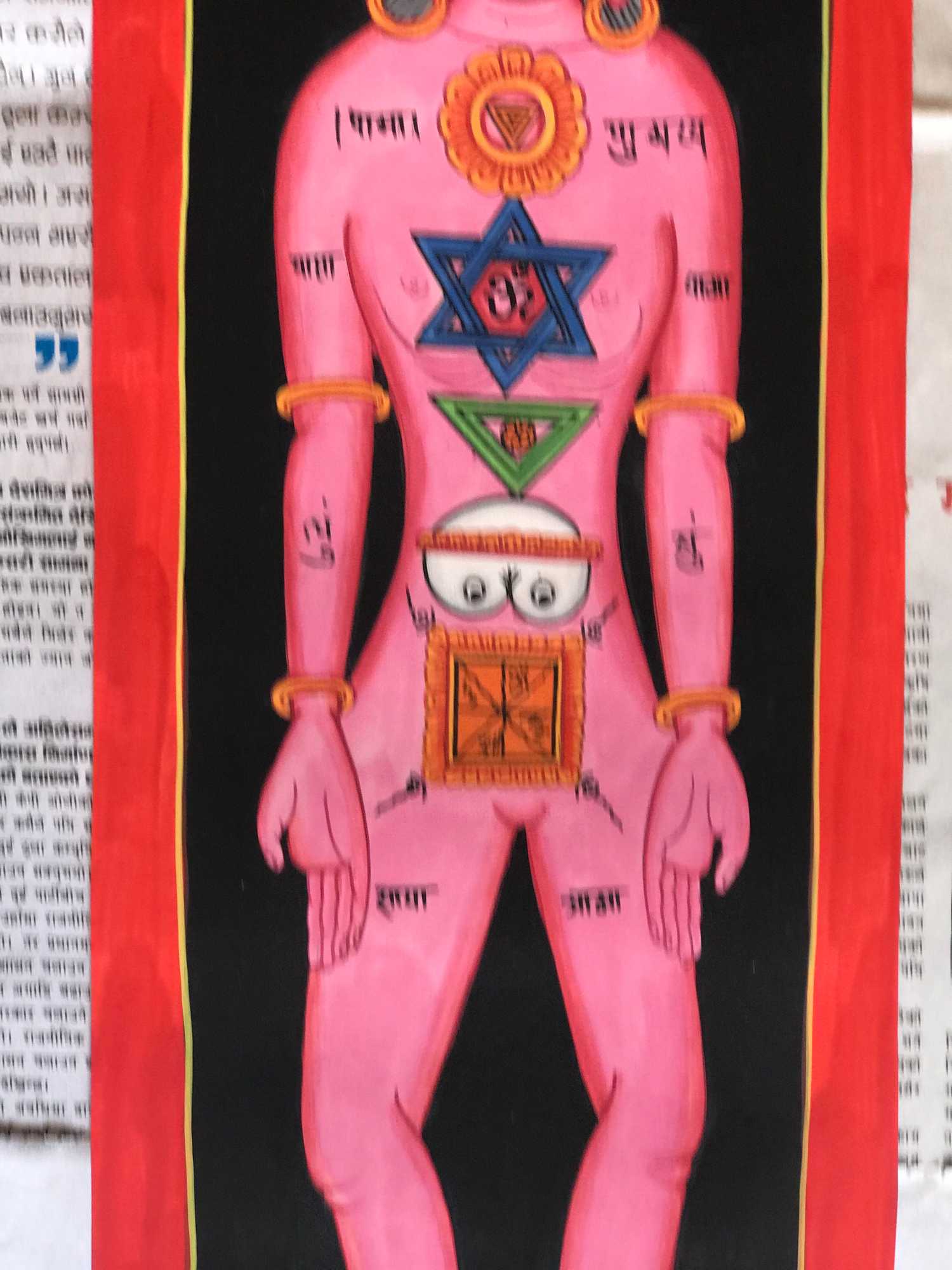Code
HCS25910
Weight
100 gm / 0.22 lbs
Size
Height
100cm (39") Width
35cm (14") Material
Cotton Canvas and Mineral Color
Availability
Available

Safe Payment
We accept Paypal, Money Transfer, Bank Transfer
Confidence
Protection covers your purchase and personal data.
Worldwide Delivery
We ship Worldwide, except Russia.Shipping cost US$25.2 for upto 0.5 kgs

Hotline
Talk to help line for your question on 9841267335Introduction to Thangka
A thangka, also known as tangka, thanka, or tanka, is a vibrant and intricate Tibetan Buddhist painting that serves as a visual representation of spiritual teachings. Crafted with meticulous detail on cotton or silk appliqué, thangkas depict a wide range of subjects including Buddhist deities, sacred scenes, mandalas, and narrative stories. These sacred artworks are traditionally kept unframed and rolled up for storage, resembling ancient scrolls. To protect their delicate nature, thangkas are mounted on textile backings and often adorned with a silk cover on the front. Proper preservation in dry environments is crucial to maintain the integrity and longevity of the silk. Read More . . .
A thangka, also known as tangka, thanka, or tanka, is a vibrant and intricate Tibetan Buddhist painting that serves as a visual representation of spiritual teachings. Crafted with meticulous detail on cotton or silk appliqué, thangkas depict a wide range of subjects including Buddhist deities, sacred scenes, mandalas, and narrative stories. These sacred artworks are traditionally kept unframed and rolled up for storage, resembling ancient scrolls. To protect their delicate nature, thangkas are mounted on textile backings and often adorned with a silk cover on the front. Proper preservation in dry environments is crucial to maintain the integrity and longevity of the silk. Read More . . .
The seven chakra system :
Chakra is various focal points used in a variety of ancient meditation practices, collectively denominated as Tantra, or the esoteric or inner traditions of Hinduism.
The concept is found in the early traditions of Hinduism. Beliefs differ between the Indian religions, with many Buddhist texts consistently mentioning five chakras, while Hindu sources offer six or even seven. Early Sanskrit texts speak of them both as meditative visualizations combining flowers and mantras and as physical entities in the body. Some modern interpreters speak of them as complexes of electromagnetic variety, the precise degree and variety of which directly arise from a synthetic average of all positive and negative so-called "fields", thus eventuating the complex Nadi. Within kundalini yoga, the techniques of breath exercises, visualizations, mudras, bandhas, kriyas, and mantras are focused on manipulating the flow of subtle energy through chakras.
The concept is found in the early traditions of Hinduism. Beliefs differ between the Indian religions, with many Buddhist texts consistently mentioning five chakras, while Hindu sources offer six or even seven. Early Sanskrit texts speak of them both as meditative visualizations combining flowers and mantras and as physical entities in the body. Some modern interpreters speak of them as complexes of electromagnetic variety, the precise degree and variety of which directly arise from a synthetic average of all positive and negative so-called "fields", thus eventuating the complex Nadi. Within kundalini yoga, the techniques of breath exercises, visualizations, mudras, bandhas, kriyas, and mantras are focused on manipulating the flow of subtle energy through chakras.
Various Images of Chakra Diagram :
| Image of chakra | location and Sound | Description |
| Crown Chakra Keynote: B Frequency: 480 Hz. Vowel: Eee Bija: Om Element: All Sound: Om Energy: Transcendence | Highest spiritual centre, pure consciousness, containing neither object nor subject. When the feminine Kundalini Shakti rises to this point, it unites with the masculine Shiva, giving self-realization and samadhi. In esoteric Buddhism, it is called Mahasukha, the petal lotus of "Great Bliss" corresponding to the fourth state of Four Noble Truths. | |
| Third Eye Chakra Keynote: A Frequency: 426.7 Hz. Vowel: Aye Bija: Sham Element: All Sound: Bells/Space Energy: Insight, Wisdom | Guru chakra or third-eye chakra, the subtle center of energy, where the tantra guru touches the seeker during the initiation ritual (saktipata). He or she commands the awakened kundalini to pass through this centre. | |
| Throat Chakra Keynote: G Frequency: 384 Hz. Vowel: Eye Bija: Ham Element: Ether Sound: Crickets Energy: Communication, Creation | The Vishuddha is iconographically represented with 16 petals covered with the sixteen Sanskrit vowels. It is associated with the element of space (akasha) and has the seed syllable of the space element Ham at its centre. The residing deity is Panchavaktra shiva, with 5 heads and 4 arms, and the Shakti is Shakini. In esoteric Buddhism, it is called Sambhoga and is generally considered to be the petal lotus of "Enjoyment" corresponding to the third state of Four Noble Truths. | |
| Heart Chakra Keynote: F Frequency: 341. 3 Hz. Vowel: Ah Bija: Yam Element: Air Sound: Wind Energy: Compassion, Love | Within it is a yantra of two intersecting triangles, forming a hexagram, symbolising a union of the male and female as well as being the esoteric symbol for the element of air (vayu). The seed mantra of air, Yam, is at its centre. The presiding deity is Ishana Rudra Shiva, and the Shakti is Kakini. In esoteric Buddhism, this Chakra is called Dharma and is generally considered to be the petal lotus of "Essential nature" and corresponding to the second state of Four Noble Truths | |
| Sacral Navel Chakra Keynote: E Vowel: Oh Frequency: 320 Hz. Bija: Ram Element: Fire Sound: Roaring Fire Element: Fire Energy: Power | For the Nath yogi meditation system, this is described as the Madhyama-Shakti or the intermediate stage of self-discovery. This chakra is represented as an downward pointing triangle representing fire in the middle of a lotus with ten petals. The seed syllable for fire is at its center Ram. The presiding deity is Braddha Rudra, with Lakini as the Shakti | |
| Sacral Chakra Keynote: D Frequency: 288 Hz Vowel: Ooo Bija: Vam Element: Water Sound: Ocean Energy: Life Energy, | Svadhisthana is represented with a lotus within which is a crescent moon symbolizing the water element. The seed mantra in its center is Vam representing water. The presiding deity is Brahma, with the Shakti being Rakini (or Chakini). In esoteric Buddhism, it is called Nirmana, the petal lotus of "Creation" and corresponding to the first state of Four Noble Truths | |
| Root Chakra Keynote: C Frequency: 256 Hz. Vowel: Uh Bija: Lam Element: Earth Sound: Thunder/Earthquake Energy: Grounding | Dormant Kundalini is often said to be resting here, wrapped three and a half, or seven or twelve times. Sometimes she is wrapped around the black Svayambhu linga, the lowest of three obstructions to her full rising (also known as knots or granthis). It is symbolised as a four-petaled lotus with a yellow square at its center representing the element of earth. The seed syllable is Lam for the earth element (pronounced lum),. All sounds, words and mantras in their dormant form rest in the muladhara chakra, where Ganesha resides, while the Shakti is Dakini. The associated animal is the elephant |


![Buddhist Hand Painting Of Seven Chakra, Bigger Samadhi, [hand Painted]](https://handicraftseller.com/uploads/pics/product/thumb/2022/07/25910.jpg)
![Buddhist Hand Painting Of Seven Chakra, Bigger Samadhi, [hand Painted]](https://handicraftseller.com/uploads/pics/product/thumb/2022/07/25910_0.jpg)
![Buddhist Hand Painting Of Seven Chakra, Bigger Samadhi, [hand Painted]](https://handicraftseller.com/uploads/pics/product/thumb/2022/07/25910_1.jpg)
![Buddhist Hand Painting Of Seven Chakra, Bigger Samadhi, [hand Painted]](https://handicraftseller.com/uploads/pics/product/thumb/2022/07/25910_2.jpg)
![Buddhist Hand Painting Of Seven Chakra, Bigger Samadhi, [hand Painted]](https://handicraftseller.com/uploads/pics/product/thumb/2022/07/25910_3.jpg)










 Nerves System" title="Medical Thangka
Nerves System" title="Medical Thangka  Seven Chakra,
Seven Chakra,  Seven Chakra,
Seven Chakra,  of Medical Thangka,
of Medical Thangka,  of Medical Thangka,
of Medical Thangka,  Human Birth Cycle" title="Medical Thangka
Human Birth Cycle" title="Medical Thangka  Seven Chakra,
Seven Chakra,  Seven Chakra,
Seven Chakra,  Bone Structure" title="Medical Thangka
Bone Structure" title="Medical Thangka  Nerves System Ii" title="Medical Thangka
Nerves System Ii" title="Medical Thangka  Seven Chakra,
Seven Chakra,  Seven Chakra,
Seven Chakra,  of Medical Thangka,
of Medical Thangka,  of Medical Thangka,
of Medical Thangka,  Seven Chakra,
Seven Chakra,  Seven Chakra,
Seven Chakra,